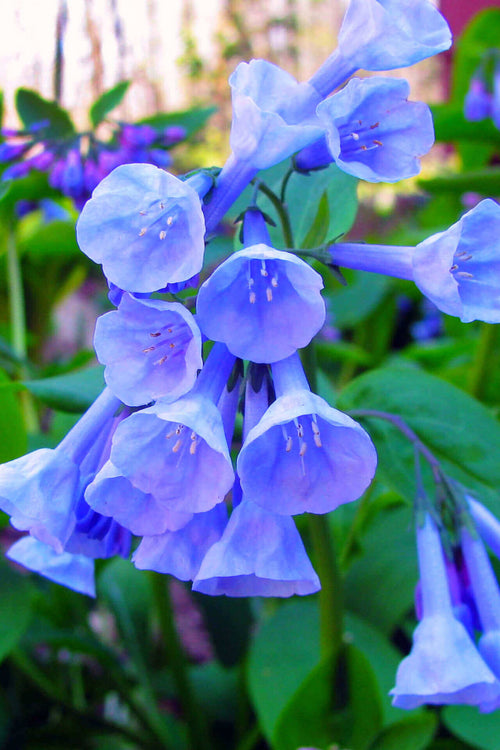The Enchanting Allure of Bluebells: Exploring a Unique Perennial
In botanical wonders, the bluebell is a testament to nature's creations' beauty and resilience. Known for its delicate yet vibrant appearance and its ability to transform woodlands into ethereal landscapes, the bluebell (Hyacinthoides non-scripta) is a unique perennial that has captured the hearts of botanists, nature enthusiasts, and artists alike. With its enchanting presence and remarkable adaptations, the bluebell holds a special place in the world of plants.
Aesthetic Majesty
One must first delve into its aesthetic majesty before discussing the bluebell. The bluebell's most distinctive feature is its bell-shaped flowers hanging delicately from slender stems. As the name suggests, these flowers come in a captivating shade of blue, ranging from the palest azure to a deep, rich cobalt. A subtle sheen often enhances the coloration, giving the petals a slightly glossy appearance that adds to their allure.
The arrangement of bluebells in woodlands is particularly enchanting. During the spring months, vast carpets of bluebells blanket the forest floors, creating a breathtaking spectacle that is both serene and mesmerizing. The sunlight filtering across the trees, casting a soft glow upon the sea of blue, evokes a sense of wonder that is difficult to put into words.
Ecological Significance
Beyond its captivating beauty, the bluebell is crucial to its ecosystem. As a perennial, it has adapted to thrive in specific environments, often forming dense colonies in woodlands and shaded areas. The timing of its bloom, usually from April to May, coincides with the period before the trees fully leaf out. This adaptation allows the bluebell to harness sunlight before the canopy becomes too dense, ensuring its survival in low-light conditions.
Furthermore, the bluebell's nectar-rich flowers are a vital food source for early-emerging pollinators such as bees and butterflies. These insects play a crucial role in pollinating various plant species, contributing to the overall health and biodiversity of the ecosystem. In this way, the bluebell exemplifies the intricate web of relationships that sustain life in the natural world.
Historical and Cultural Significance
The bluebell's allure extends beyond its ecological role, permeating human culture and history. In many cultures, bluebells symbolize gratitude, humility, and everlasting love. In folklore, they are often linked to fairy realms and magical enchantments, enhancing their mystique and captivating the human imagination.
Bluebells have been used for their medicinal properties in some parts of the world. Historically, bluebell extracts were believed to possess properties that could aid in treating specific ailments, such as coughs and digestive issues. However, it's important to note that the plant can be toxic if ingested in large quantities, emphasizing the delicate balance between its potential benefits and risks.
Conservation Challenges
Despite its enchanting presence, the bluebell faces specific conservation challenges. Habitat loss due to urbanization, deforestation, and changes in land use can disrupt the delicate ecosystems where bluebells thrive. Invasive species can also pose a threat by outcompeting native plants and altering the dynamics of the woodland environment.
Efforts to conserve bluebell populations include protecting and restoring their natural habitats and raising awareness about their importance. Some areas have designated bluebell woods as protected sites, allowing these unique perennials to continue enchanting future generations.
Cultivation and Care
Cultivation and care are essential considerations for those who wish to introduce the magic of bluebells into their own gardens. Bluebells can be grown from bulbs and are often planted in the fall for spring bloom. They prefer shaded or partially shaded areas with well-draining soil. When planting, it's essential to handle the bulbs carefully, as they are fragile and susceptible to damage.
Once established, bluebells are relatively low-maintenance, requiring minimal attention beyond occasional watering and mulching to retain soil moisture. It's important to avoid disturbing established colonies, as bluebells can spread and naturalize over time, creating breathtaking displays reminiscent of their wild counterparts.
Conclusion
With its enchanting beauty, ecological significance, and cultural symbolism, the bluebell stands as a unique perennial that captivates all who encounter it. From its delicate blue flowers that transform woodlands into fairy tale landscapes to its vital role in supporting pollinators and its historical ties to human culture, the bluebell holds a special place in the intricate tapestry of life on Earth.
As we continue to appreciate and understand the importance of preserving biodiversity, the bluebell reminds us of the delicate balance in our ecosystems. By nurturing these captivating perennials and their habitats, we contribute to protecting both natural beauty and the intricate relationships that sustain life on our planet.



















































